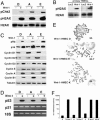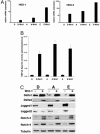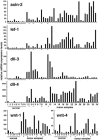Increased Wnt signaling triggers oncogenic conversion of human breast epithelial cells by a Notch-dependent mechanism
- PMID: 16501043
- PMCID: PMC1450156
- DOI: 10.1073/pnas.0600065103
Increased Wnt signaling triggers oncogenic conversion of human breast epithelial cells by a Notch-dependent mechanism
Abstract
Wnt and Notch signaling have long been established as strongly oncogenic in the mouse mammary gland. Aberrant expression of several Wnts and other components of this pathway in human breast carcinomas has been reported, but evidence for a causative role in the human disease has been missing. Here we report that increased Wnt signaling, as achieved by ectopic expression of Wnt-1, triggers the DNA damage response (DDR) and an ensuing cascade of events resulting in tumorigenic conversion of primary human mammary epithelial cells. Wnt-1-transformed cells have high telomerase activity and compromised p53 and Rb function, grow as spheres in suspension, and in mice form tumors that closely resemble medullary carcinomas of the breast. Notch signaling is up-regulated through a mechanism involving increased expression of the Notch ligands Dll1, Dll3, and Dll4 and is required for expression of the tumorigenic phenotype. Increased Notch signaling in primary human mammary epithelial cells is sufficient to reproduce some aspects of Wnt-induced transformation. The relevance of these findings for human breast cancer is supported by the fact that expression of Wnt-1 and Wnt-4 and of established Wnt target genes, such as Axin-2 and Lef-1, as well as the Notch ligands, such as Dll3 and Dll4, is up-regulated in human breast carcinomas.
Conflict of interest statement
Conflict of interest statement: No conflicts declared.
Figures




Similar articles
-
Fibroblast growth factor 9 has oncogenic activity and is a downstream target of Wnt signaling in ovarian endometrioid adenocarcinomas.Cancer Res. 2006 Feb 1;66(3):1354-62. doi: 10.1158/0008-5472.CAN-05-3694. Cancer Res. 2006. PMID: 16452189
-
Wnt signalling in human breast cancer: expression of the putative Wnt inhibitor Dickkopf-3 (DKK3) is frequently suppressed by promoter hypermethylation in mammary tumours.Breast Cancer Res. 2008;10(5):R82. doi: 10.1186/bcr2151. Epub 2008 Sep 30. Breast Cancer Res. 2008. PMID: 18826564 Free PMC article.
-
Wnt-1 and int-2 mammary oncogene effects on the beta-catenin pathway in immortalized mouse mammary epithelial cells are not sufficient for tumorigenesis.Oncogene. 2001 Nov 15;20(52):7645-57. doi: 10.1038/sj.onc.1204980. Oncogene. 2001. PMID: 11753642
-
Notch signaling and breast cancer.Adv Exp Med Biol. 2012;727:241-57. doi: 10.1007/978-1-4614-0899-4_18. Adv Exp Med Biol. 2012. PMID: 22399352 Review.
-
Notch signaling as a therapeutic target for breast cancer treatment?Breast Cancer Res. 2011 May 31;13(3):210. doi: 10.1186/bcr2875. Breast Cancer Res. 2011. PMID: 21672271 Free PMC article. Review.
Cited by
-
KRT19 directly interacts with β-catenin/RAC1 complex to regulate NUMB-dependent NOTCH signaling pathway and breast cancer properties.Oncogene. 2017 Jan 19;36(3):332-349. doi: 10.1038/onc.2016.221. Epub 2016 Jun 27. Oncogene. 2017. PMID: 27345400 Free PMC article.
-
Chronic chemotherapeutic stress promotes evolution of stemness and WNT/beta-catenin signaling in colorectal cancer cells: implications for clinical use of WNT-signaling inhibitors.Oncotarget. 2015 Jul 30;6(21):18518-33. doi: 10.18632/oncotarget.3934. Oncotarget. 2015. PMID: 26041882 Free PMC article.
-
Targeting beta-catenin signaling to induce apoptosis in human breast cancer cells by z-guggulsterone and Gugulipid extract of Ayurvedic medicine plant Commiphora mukul.BMC Complement Altern Med. 2013 Aug 3;13:203. doi: 10.1186/1472-6882-13-203. BMC Complement Altern Med. 2013. PMID: 23914993 Free PMC article.
-
The Notch Pathway in Breast Cancer Progression.ScientificWorldJournal. 2018 Jul 8;2018:2415489. doi: 10.1155/2018/2415489. eCollection 2018. ScientificWorldJournal. 2018. PMID: 30111989 Free PMC article. Review.
-
Small GTPase RhoE/Rnd3 is a critical regulator of Notch1 signaling.Cancer Res. 2014 Apr 1;74(7):2082-93. doi: 10.1158/0008-5472.CAN-12-0452. Epub 2014 Feb 13. Cancer Res. 2014. PMID: 24525741 Free PMC article.
References
-
- Ellis I. O., Schnitt S. J., Sastre-Garau X., Bussolati G., Tarassoli F. A., Eusebi V., Peterse J. L., Mukai K., Tabár L., Jacquemeir J. In: Pathology and Genetics of Tumours of the Breast and Female Genital Organs. Tavassoli F., Devilee P., editors. Vol. 5. Lyon, France: International Agency for Research on Cancer; 2003. pp. 13–59.
-
- Hanahan D., Weinberg R. A. Cell. 2000;100:57–70. - PubMed
-
- Cardiff R. D., Bern H. A., Faulkin L. J., Daniel C. W., Smith G. H., Young L. J., Medina D., Gardner M. B., Wellings S. R., Shyamala G., et al. Comp. Med. 2002;52:12–31. - PubMed
-
- Rangarajan A., Weinberg R. A. Nat. Rev. Cancer. 2003;3:952–959. - PubMed
Publication types
MeSH terms
Substances
LinkOut - more resources
Full Text Sources
Other Literature Sources
Molecular Biology Databases
Research Materials
Miscellaneous

